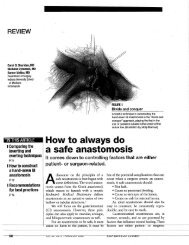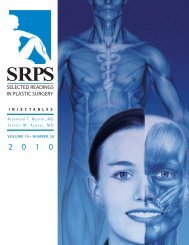SRPS PS - Plastic Surgery Internal
SRPS PS - Plastic Surgery Internal
SRPS PS - Plastic Surgery Internal
You also want an ePaper? Increase the reach of your titles
YUMPU automatically turns print PDFs into web optimized ePapers that Google loves.
<strong>SR<strong>PS</strong></strong> Volume 10, Issue 25, 2009<br />
artery, and Braun et al. 458 similarly elevated a<br />
retrograde radial fascial turn-down flap based on<br />
distal perforators of the radial artery, leaving the main<br />
radial artery intact.<br />
The unesthetic and potentially unstable grafted<br />
donor site of the radial forearm flap remains the<br />
major detractor of this otherwise excellent flap. 459 Skin<br />
graft take usually is not a problem with flaps used for<br />
hand reconstruction, because the flap is based<br />
proximally over the muscle bellies. If the flap needs<br />
to be raised in the distal forearm over the flexor<br />
tendons, graft take can be improved by a suprafascial<br />
dissection of the flap. 460 Many methods have been<br />
proposed to improve the donor site, including direct<br />
closure, full-thickness skin grafts, local flaps, and<br />
tissue expansion. 461–466 Split thickness skin grafting<br />
remains the standard at most centers.<br />
In 1984, Lovie et al. 467 described the ulnar artery<br />
island flap and 4 years later reported their experience<br />
with this method for hand and forearm<br />
reconstruction. 468 The skin territory of the flap overlies<br />
the proximal ulnar aspect of the forearm, which is<br />
almost always hairless and less visible than the radial<br />
border. The authors and others 469–472 found the ulnar<br />
flap to be superior in terms of esthetics, easier<br />
harvesting of bone and muscle (flexor carpi ulnaris),<br />
direct closure of donor site, and lower morbidity.<br />
The posterior interosseous artery flap is based on<br />
the communication between the anterior and posterior<br />
interosseous arteries. 473–478 The posterior interosseous<br />
artery runs in a fascial septum between the extensor<br />
carpi ulnaris and extensor digiti minimi muscles (Fig.<br />
17). 479 A segment of ulna can be taken as a composite<br />
flap. 480 The advantages of this flap are good pedicle<br />
length and primary closure of the donor site. Its<br />
disadvantages are a relatively hairy donor site, an<br />
obvious scar on the visible dorsum of the forearm,<br />
limited size of the flap, and unreliability of the<br />
vascular communication. 481–484<br />
Distant Flaps<br />
Large flaps of skin can be transferred to the hand from<br />
distant sites by means of traditional pedicled<br />
techniques or microvascular free tissue transfer.<br />
Pedicled flaps—Flaps of skin from remote sites<br />
over the chest and abdomen traditionally were used<br />
26<br />
Figure 17. Cross-section of distally based posterior<br />
interosseous island flap taken at middle one-third of forearm.<br />
Posterior interosseous artery reaches overlying skin in space<br />
between extensor carpi ulnaris and extensor digiti minimi<br />
proprius. (Reprinted with permission from Landi et al. 479 )<br />
for resurfacing large wounds of the upper extremity.<br />
The most commonly used pedicled flap is the groin<br />
flap based on the superficial circumflex iliac artery 485–488<br />
or the superficial inferior epigastric artery. 489 Groin<br />
flaps are axial-pattern flaps with reliable vascularity.<br />
However, they necessitate two surgical stages and the<br />
hand remains dependent during the initial period of<br />
flap attachment, encouraging edema and stiffness. In<br />
addition, groin flaps are too bulky for dorsal hand<br />
resurfacing and require subsequent revision surgery.<br />
Chow et al. 490 presented their experience with 36<br />
groin flaps used in delayed primary or elective<br />
secondary hand resurfacing. Arner and Möller 491<br />
highlighted potential complications.<br />
Microvascular Free Tissue Transfer—Microvascular<br />
free tissue transfer allows a single-stage composite<br />
reconstruction of complex hand defects, 492–500 obviating<br />
the need for cumbersome, two-stage pedicled<br />
procedures and their inherent shortcomings. Free flaps<br />
can also be used to provide vascular conduits and soft<br />
tissue coverage. 501,502 Free flaps are the definitive form<br />
of soft-tissue cover in emergency situations. 503–508<br />
Successful reconstruction of soft tissue of the upper<br />
extremity with free flaps must be approached with the<br />
goals of providing stable coverage and, more<br />
importantly, restoring function. The hand does not<br />
tolerate prolonged immobilization. Radical débridement<br />
and restoration of all tissue components at the time of<br />
coverage encourages early mobilization. 509






